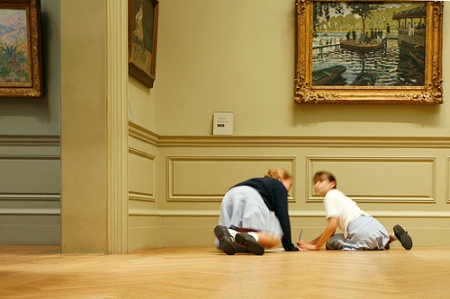
No Museum is an Island
November 11, 2008
“All mankind is of one author, and is one volume; when one man dies, one chapter is not torn out of the book, but translated into a better language; and every chapter must be so translated…As therefore the bell that rings to a sermon, calls not upon the preacher only, but upon the congregation to come: so this bell calls us all: but how much more me, who am brought so near the door by this sickness….No man is an island, entire of itself…any man’s death diminishes me, because I am involved in mankind; and therefore never send to know for whom the bell tolls; it tolls for thee.”
This quote from John Donne’s “Meditation XVII” explains no person is isolated and we are all interconnected. Even though Donne wrote this poem a very long time ago it still rings true today (pardon the pun). In our personal lives it is important to remember what Donne was trying to tell us, the actions of one person can affect us all. This lesson is also important for businesses to be successful.
Businesses and art museums would do well to remember Donne’s lesson. It is important for any business to remember it is interconnected with the community it resides in, and it is a good practice to keep your community engaged. This is especially true for art museums because they can only thrive if they have a strong connection with their community.
Creating connections
Museums stay connected with their community in a mulitude of ways. Public programming, working with area schools and guest lectures are all common ways that art museums stay connected.
For example
One of the reasons to visit an art museum is to learn, so having experts give lectures is a great way to share knowledge with the public. Earlier this year, Kent State’s own Albert Reischuck, assistant professor, gave a series of lectures at the Akron Art Musuem that converged art and modern culture. According to the article in the Daily Kent Stater, Reischuck was asked to lecture because the Akron Art Museum was closed for renovations but they still wanted to keep their audience engaged with the museum’s collection. I had Reischuck one semester for a 20th century European art history class. He had a way of keeping the class involved with his lecture that was really great. I always wanted to go and I never felt like falling asleep.
Another example
The Cincinnati Art Museum is creating connections early on with their community.
The museum hosts a monthly program titled “Wee Wednesdays” that allows children ages 2-5 to tour the museum through story sessions and scavenger hunts with objects the children can touch. This program gets parents involved and instills a love of art early on so hopefully the children will want to keep coming back as they get older.
One more example
The Metropolitan Museum of Art in New York City started something extraordinary last year that will no doubt connect the museum with people across the country. The Met is making high-resolution digital images of the museum’s collection available to scholars for free. This is so amazing because it will provide very high quality images to art history students. I know that the grainy and discolored slides I have to look at pale in comparison to digital images. It is impossible for most students to see all these important works in person so having a digital image is the next best thing. For the Met it means increasing their mission to educate people about art. It also generates a lot of good feelings from one of their most important publics, art historians.
Final thoughts
Engaging audiences and creating connections are among the most important things a public relations practitioner does. Therefore, Donne’s poem, written hundreds of years ago, is still relevant today. Public relations grew out of this idea of mankind being interconnected. Businesses need these connections to thrive and it is the job of public relations practitioners to come up with innovative ways to create connections.
How do you create connections?


“Public relations grew out of this idea of mankind being interconnected.”
That’s a fundamental truth of Natural Law theory.
“Businesses need these connections to thrive and it is the job of public relations practitioners to come up with innovative ways to create connections.”
That’s a fundamental truth of how capitalists exploit Natural Law theory.
Interesting notion. I didn’t put Natural Law theory into my post on purpose. I’m not even sure if I understand it completely, but thanks for bringing it up! 😉